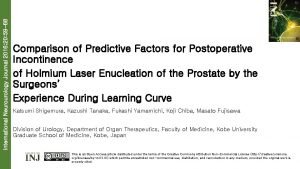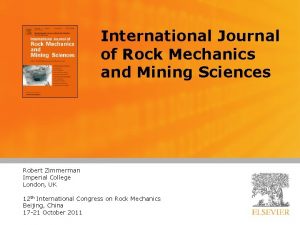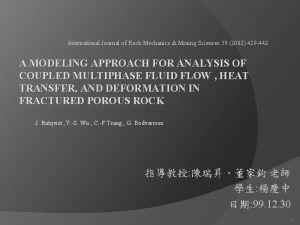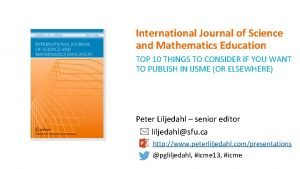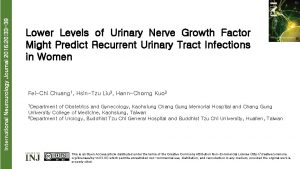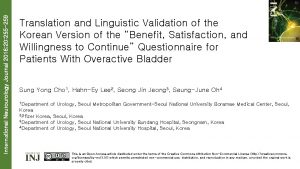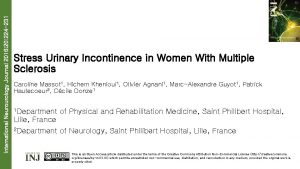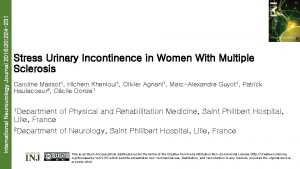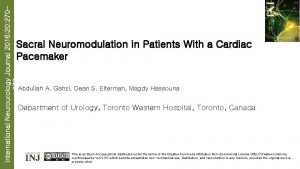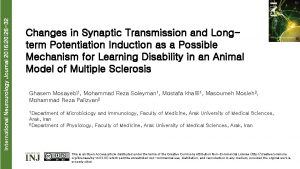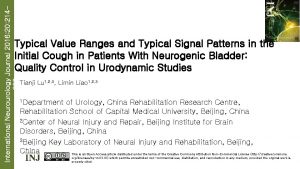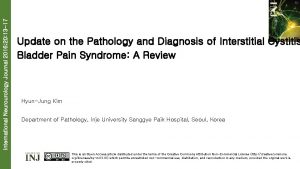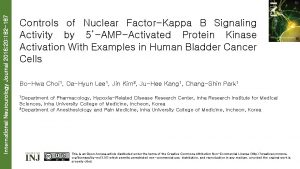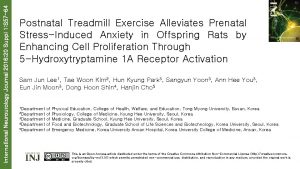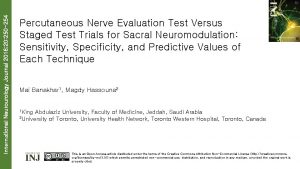International Neurourology Journal 2016 20 188196 The Early















- Slides: 15

International Neurourology Journal 2016; 20: 188196 The Early Histological Effects of Intravesical Instillation of Platelet-Rich Plasma in Cystitis Models M. İrfan Dönmez 1, Kubilay İnci 1, †, Naciye Dilara Zeybek 2, H. Serkan Doğan 1, Ali Ergen 1 1 Department of Urology, Hacettepe University School of Medicine, Ankara, Turkey 2 Department of Histology and Embryology, Hacettepe University School of Medicine, Ankara, Turkey This is an Open Access article distributed under the terms of the Creative Commons Attribution Non-Commercial License (http: //creativecommons. org/licenses/by-nc/3. 0/) which permits unrestricted non-commercial use, distribution, and reproduction in any medium, provided the original work is properly cited.

International Neurourology Journal 2016; 20: 188196 PURPOSE • To evaluate the early histological effects of the intravesical instillation of platelet-rich plasma (PRP) in rabbit models of interstitial and hemorrhagic cystitis.

International Neurourology Journal 2016; 20: 188196 METHODS • Thirty-six rabbits were classified into 6 groups: saline (S), S+PRP, hydrochloric acid (HCl), HCl+PRP, cyclophosphamide (Cy. P), and Cy. P+PRP. • At 48 hours after induction, PRP was prepared and intravesically administered to the S+PRP, HCl+PRP, and Cy. P+PRP groups. • Bladder sections were stained with toluidine blue for mast cell counting and with hematoxylin and eosin for histopathology and mitotic index determination. • The proliferation index was determined by proliferating cell nuclear antigen (PCNA) immunolabeling. • The nonparametric Mann-Whitney U-test was used for statistical analysis.

International Neurourology Journal 2016; 20: 188196 RESULTS • No abnormalities were observed in the S group, whereas increased interstitial edema and increased average mitotic and proliferation indices were observed in the S+PRP group (P=0. 023, P=0. 004, and P=0. 009, respectively). • Intense epithelial loss, hemorrhage, and leukocyte infiltration were detected in the HCl and HCl+PRP groups, whereas a significantly increased average mitotic index was observed in the HCl+PRP group (P=0. 002). • When compared with its Cy. P counterpart, a significant reduction in hemorrhage and an increase in leukocyte infiltration and mitotic index were observed in the Cy. P+PRP group (P=0. 006, P=0. 038, and P=0. 002, respectively). • In addition, PCNA staining revealed a significantly increased proliferation index in the HCl+PRP and Cy. P+PRP groups (P=0. 032 and P=0. 015,

International Neurourology Journal 2016; 20: 188196 CONCLUSIONS • The intravesical instillation of PRP increased the mitotic index in the saline and cyclophosphamide groups while decreasing macroscopic bleeding.

International Neurourology Journal 2016; 20: 188196 Table 1. Working schedule

International Neurourology Journal 2016; 20: 188196 Table 2. Histologic changes between groups

International Neurourology Journal 2016; 20: 188196 Fig. 1. Macroscopic view of a urinary bladder from the Cy. P (A) and Cy. P+PRP (B) groups. Cy. P, cyclophosphamide; PRP, platelet-rich plasma.

International Neurourology Journal 2016; 20: 188196

International Neurourology Journal 2016; 20: 188196 Fig. 2. Histopathologic changes in the cystitis models and the effects of PRP administration. Regular morphology of a urinary bladder with intact urothelium in the S (A) and S+PRP groups (B). Loss of urothelial cells, hemorrhage, and congested blood vessels (V) in the HCl (C) and Cy. P cystitis models (E). Edema (*) in the S+PRP group (B) and cystitis models (D, F). H&E, original magnification, × 25. S, saline; PRP, platelet-rich plasma; HCl, hydrochloric acid; Cy. P, cyclophosphamide.

International Neurourology Journal 2016; 20: 188196

International Neurourology Journal 2016; 20: 188196 Fig. 3. Normal mucosa with intact urothelium and regular lamina propria in the S (A) and S+PRP groups (B). Denuded epithelia and prominent hemorrhage in the HCl cystitis model (C). Hemorrhage and mucosal abrasion in the HCl+PRP group (D). Degeneration of epithelial cells and prominent hemorrhage in the Cy. P cystitis model (E). Significantly decreased hemorrhage in the Cy. P+PRP group (F). H&E, original magnification, × 200. S, saline; PRP, platelet-rich plasma; HCl, hydrochloric acid; Cy. P, cyclophosphamide.

International Neurourology Journal 2016; 20: 188196

International Neurourology Journal 2016; 20: 188196

International Neurourology Journal 2016; 20: 188196 Fig. 4. Proliferating cell nuclear antigen (PCNA) immunoreactivity in the urothelium of the urinary bladder. The number of PCNA-immunopositive cells was lower in the saline (A) and cystitis models (C, E) than in the PRP-administered groups (B, D, F). A significant increase (approximately 20%) in the PCNA-positive cell number was detected in the urothelium of the PRP-administered groups (G). The bars represent mean±standard error of the mean. The negative control where the primary antibody was replaced with its isotype (H). *P<0. 05. Original magnification, × 400. PRP, platelet-rich plasma; HCl, hydrochloric acid; Cy. P, cyclophosphamide.
 International neurourology journal
International neurourology journal Article paru dans le journal le monde en 2016
Article paru dans le journal le monde en 2016 Early cpr and early defibrillation can: *
Early cpr and early defibrillation can: * Rock mechanics and mining sciences
Rock mechanics and mining sciences International journal of rock mechanics and mining sciences
International journal of rock mechanics and mining sciences International journal of science and mathematics education
International journal of science and mathematics education Hình ảnh bộ gõ cơ thể búng tay
Hình ảnh bộ gõ cơ thể búng tay Slidetodoc
Slidetodoc Bổ thể
Bổ thể Tỉ lệ cơ thể trẻ em
Tỉ lệ cơ thể trẻ em Chó sói
Chó sói Chụp tư thế worms-breton
Chụp tư thế worms-breton Hát lên người ơi alleluia
Hát lên người ơi alleluia Các môn thể thao bắt đầu bằng tiếng chạy
Các môn thể thao bắt đầu bằng tiếng chạy Thế nào là hệ số cao nhất
Thế nào là hệ số cao nhất Các châu lục và đại dương trên thế giới
Các châu lục và đại dương trên thế giới
